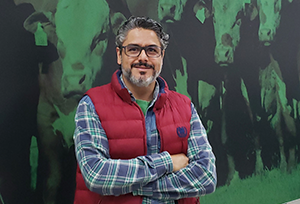Xisto de Souza, CEO of JetBov, beef cattle startup, comments on Agriculture 4.0
Brazilian cattle ranching is as extensive as the national territory. According to a study by Embrapa, 80% of Brazilian pastures manifest a certain degree of degradation. However, day by day, livestock has become professionalized and has invested in technology to obtain more yield.
AgriBrasilis interviewed Xisto Alves de Souza Jr., CEO and Founder of the Startup JetBov, which propose solutions in beef cattle farming through an application. Xisto is a specialist in strategic planning and software engineering, has a degree in business administration with an emphasis on foreign trade and a postgraduate degree in software engineering and strategic planning and management from the Pontifical Catholic University of the Paraná State.
AgriBrasilis: How does the app work in terms of breeding, raising and finishing? What about property management?
Xisto: We are a platform for complete management. We attend the stages of breeding, raising and finishing. We are very different in the market for our position of helping the farmer to manage the farm as a company. For this, we facilitate the collection of data in the field through our app that works offline and converses with other devices such as electronic scales and sensors. We integrate these zootechnical data, which arrive at all times from the field, to monitor the stocking of pastures using satellite images. As a relevant differential of the solution, the system calculates the entire production cost, so that the farmer has at hand, at any time, what the cost was with each animal and thus better project the performance of the cattle, stocking for optimization of land use seeking the best economic and financial result. In practice, we implant in our customers’ farm what we call precision cattle breeding, derived from the concepts of Agriculture 4.0, enabling properties to carry out a more modern cattle breeding, with more data-based decisions that seek to maximize profitability in a sustainable manner.
AgriBrasilis: Can the same technology be implemented for the production of other kinds of animals?
Xisto: We are specialized in beef cattle. Our purpose is to promote the empowerment of farmers through information technology. In this way, we are totally focused on getting to know our customers deeply, and thus continuously evolving our services to increasingly add value to them.
AgriBrasilis: What are the main barriers to the implementation of new technologies in Brazil?
Xisto: We believe that connectivity barriers in the countryside are the main obstacle, which creates a great delay for the development of the economy in the countryside. Considering that, not only with regard to the use of digital technologies directly, but also in relation to the qualification of the workforce itself, it will increasingly need to master the use of these new technologies for application on farms.
AgriBrasilis: Tell us a little about the differences between traditional livestock, still very common in the national territory, and new livestock, as a professional business model. Between the profitability of cattle farming, what are the differences?
Xisto: A study presented by the consultancy Athenagro, which promotes the Livestock Rally, comparing the most profitable farms, with regard to Profit/Ha, we have a potential in Brazil to produce up to 8 times more. And, we understand that one of the fundamental factors that differentiate traditional livestock from this new, highly profitable one, is directly related to professionalization in management. Decisions on investments in genetics, intensification of pastures, supplementation, health, environmental issues, etc. They need to be better controlled and monitored to make decisions in real time, increasingly based on data. And considering that livestock is an extremely complex activity in terms of the variety of information and all the dynamics involved, not using digital technology as a tool will differentiate between a good manager and a bad manager in the new livestock.

